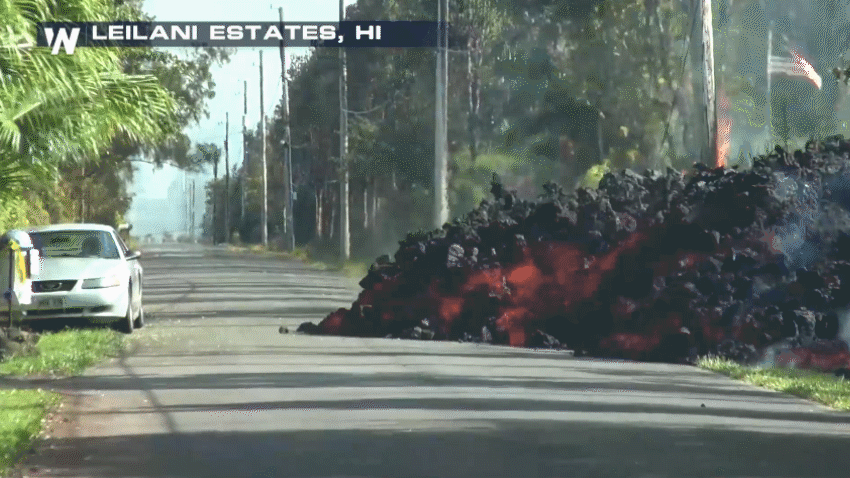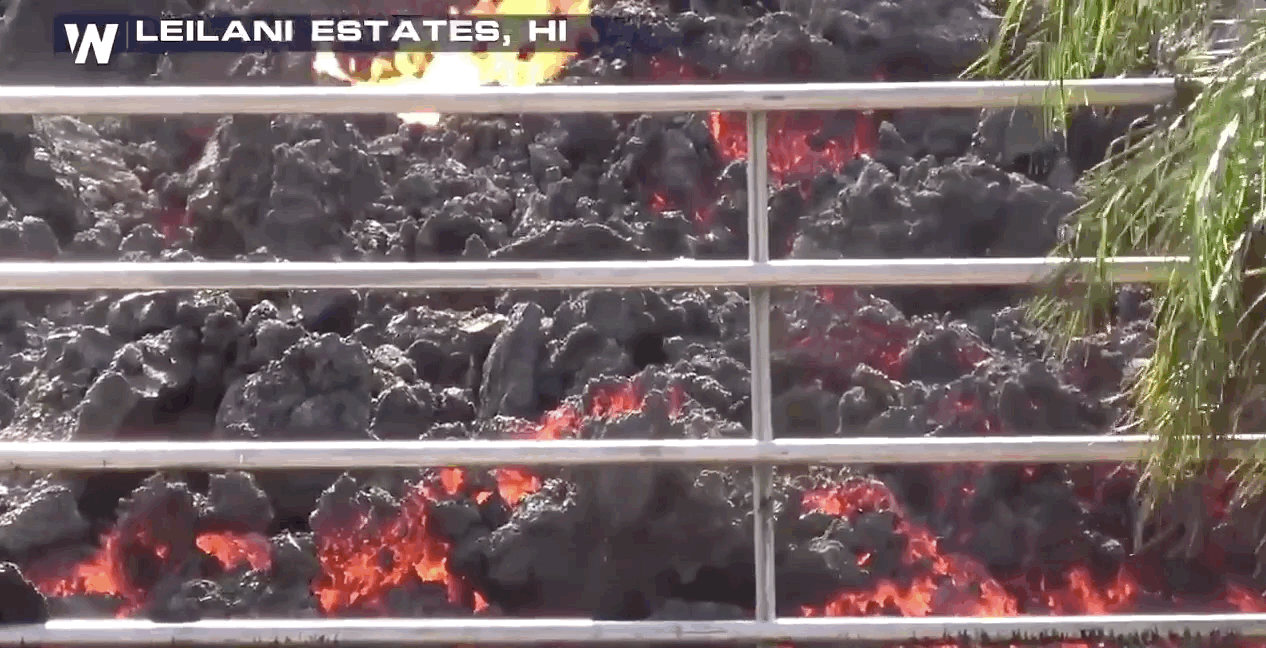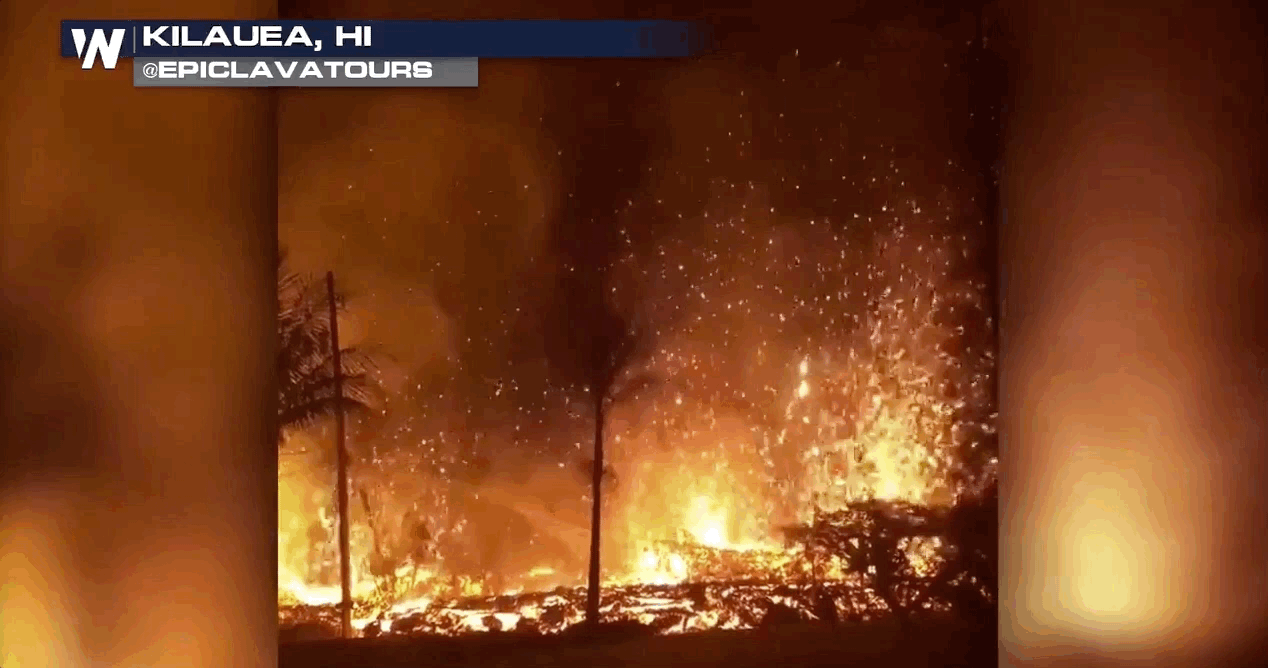The Science Behind Hawaii’s Car-Eating, Lava-Filled Fissures
Special Stories
7 May 2018 3:19 PM
The fiery fissures currently causing chaos on Hawaii’s Big Island have demolished nearly 30 homes, leaving piles of cooled lava in its path. While the red-hot liquid brings destruction to everything it touches, the science behind the geologic phenomenon is fascinating.
 The volcano responsible, Kilauea, has been dubbed the most active volcano on the planet says Dr. Wendy Stovall, a volcanologist with the United States Geologic Survey (USGS). Kilauea has been in continuous eruption since 1983 causing periodic disruptions for nearby residents.
All of the volcanic activity in Hawaii can be attributed to a geologic hot spot where unusual amounts of magma continually rise to Earth’s surface. Dr. Leilani Arthurs, a professor at the University of Colorado and former USGS geologist, says, “[Geologists] don’t understand all of the nuances about what makes up hot spots”. They do know, however, that hot spots are responsible for building islands around the world, including Hawaii.
As magma swells beneath Earth’s surface, pressure begins to build. Pressurized magma can cause rocks to fracture resulting in numerous low magnitude earthquakes. “These kinds of earthquakes or tremors are usually less than magnitude four,” says Dr. Arthurs. Hundreds of these earthquakes have already occurred around Kilauea over the past week.
The volcano responsible, Kilauea, has been dubbed the most active volcano on the planet says Dr. Wendy Stovall, a volcanologist with the United States Geologic Survey (USGS). Kilauea has been in continuous eruption since 1983 causing periodic disruptions for nearby residents.
All of the volcanic activity in Hawaii can be attributed to a geologic hot spot where unusual amounts of magma continually rise to Earth’s surface. Dr. Leilani Arthurs, a professor at the University of Colorado and former USGS geologist, says, “[Geologists] don’t understand all of the nuances about what makes up hot spots”. They do know, however, that hot spots are responsible for building islands around the world, including Hawaii.
As magma swells beneath Earth’s surface, pressure begins to build. Pressurized magma can cause rocks to fracture resulting in numerous low magnitude earthquakes. “These kinds of earthquakes or tremors are usually less than magnitude four,” says Dr. Arthurs. Hundreds of these earthquakes have already occurred around Kilauea over the past week.
 When the magma-induced pressure becomes so high, the fiery liquid eventually bursts through Earth’s surface forming destructive lava filled fissures. Dr. Stovall and the team at USGS were tracking the potential for lava flows before eruption by monitoring small earthquakes correlated with the magma’s movement.
Another sure sign of an eruption is land deformation, which is a geology speak for rising and sinking of the ground. Stovall noted, “There was significant deformation upward. It was steady and it kept climbing over a period of two weeks.” Eventually, something’s gotta give.
While these events can take residents by surprise, eruptions aren’t foreign to the Big Island. Dr. Arthurs, a Hawaii native, remembers two recent eruptions, “Two really notable fissure eruptions Mauna Ulu which erupted from 1969 to 1974 and Pu`u `O`o, which begin in 1983 and continues today.”
When the magma-induced pressure becomes so high, the fiery liquid eventually bursts through Earth’s surface forming destructive lava filled fissures. Dr. Stovall and the team at USGS were tracking the potential for lava flows before eruption by monitoring small earthquakes correlated with the magma’s movement.
Another sure sign of an eruption is land deformation, which is a geology speak for rising and sinking of the ground. Stovall noted, “There was significant deformation upward. It was steady and it kept climbing over a period of two weeks.” Eventually, something’s gotta give.
While these events can take residents by surprise, eruptions aren’t foreign to the Big Island. Dr. Arthurs, a Hawaii native, remembers two recent eruptions, “Two really notable fissure eruptions Mauna Ulu which erupted from 1969 to 1974 and Pu`u `O`o, which begin in 1983 and continues today.”
 Geologists aren’t exactly sure what the current eruption has in store but recent data has Stovall relatively optimistic, “Fissure 8, which was producing massive lava flows yesterday, ceased producing lava at the surface.” But she notes, “The course of events for these eruptions is that they come and go. It can stop for a few days and then it can start back up again.”
For the latest info please monitor USGS.gov and USGS Volcanoes.
Written by: Dakota Smith.
Geologists aren’t exactly sure what the current eruption has in store but recent data has Stovall relatively optimistic, “Fissure 8, which was producing massive lava flows yesterday, ceased producing lava at the surface.” But she notes, “The course of events for these eruptions is that they come and go. It can stop for a few days and then it can start back up again.”
For the latest info please monitor USGS.gov and USGS Volcanoes.
Written by: Dakota Smith.
 The volcano responsible, Kilauea, has been dubbed the most active volcano on the planet says Dr. Wendy Stovall, a volcanologist with the United States Geologic Survey (USGS). Kilauea has been in continuous eruption since 1983 causing periodic disruptions for nearby residents.
All of the volcanic activity in Hawaii can be attributed to a geologic hot spot where unusual amounts of magma continually rise to Earth’s surface. Dr. Leilani Arthurs, a professor at the University of Colorado and former USGS geologist, says, “[Geologists] don’t understand all of the nuances about what makes up hot spots”. They do know, however, that hot spots are responsible for building islands around the world, including Hawaii.
As magma swells beneath Earth’s surface, pressure begins to build. Pressurized magma can cause rocks to fracture resulting in numerous low magnitude earthquakes. “These kinds of earthquakes or tremors are usually less than magnitude four,” says Dr. Arthurs. Hundreds of these earthquakes have already occurred around Kilauea over the past week.
The volcano responsible, Kilauea, has been dubbed the most active volcano on the planet says Dr. Wendy Stovall, a volcanologist with the United States Geologic Survey (USGS). Kilauea has been in continuous eruption since 1983 causing periodic disruptions for nearby residents.
All of the volcanic activity in Hawaii can be attributed to a geologic hot spot where unusual amounts of magma continually rise to Earth’s surface. Dr. Leilani Arthurs, a professor at the University of Colorado and former USGS geologist, says, “[Geologists] don’t understand all of the nuances about what makes up hot spots”. They do know, however, that hot spots are responsible for building islands around the world, including Hawaii.
As magma swells beneath Earth’s surface, pressure begins to build. Pressurized magma can cause rocks to fracture resulting in numerous low magnitude earthquakes. “These kinds of earthquakes or tremors are usually less than magnitude four,” says Dr. Arthurs. Hundreds of these earthquakes have already occurred around Kilauea over the past week.
 When the magma-induced pressure becomes so high, the fiery liquid eventually bursts through Earth’s surface forming destructive lava filled fissures. Dr. Stovall and the team at USGS were tracking the potential for lava flows before eruption by monitoring small earthquakes correlated with the magma’s movement.
Another sure sign of an eruption is land deformation, which is a geology speak for rising and sinking of the ground. Stovall noted, “There was significant deformation upward. It was steady and it kept climbing over a period of two weeks.” Eventually, something’s gotta give.
While these events can take residents by surprise, eruptions aren’t foreign to the Big Island. Dr. Arthurs, a Hawaii native, remembers two recent eruptions, “Two really notable fissure eruptions Mauna Ulu which erupted from 1969 to 1974 and Pu`u `O`o, which begin in 1983 and continues today.”
When the magma-induced pressure becomes so high, the fiery liquid eventually bursts through Earth’s surface forming destructive lava filled fissures. Dr. Stovall and the team at USGS were tracking the potential for lava flows before eruption by monitoring small earthquakes correlated with the magma’s movement.
Another sure sign of an eruption is land deformation, which is a geology speak for rising and sinking of the ground. Stovall noted, “There was significant deformation upward. It was steady and it kept climbing over a period of two weeks.” Eventually, something’s gotta give.
While these events can take residents by surprise, eruptions aren’t foreign to the Big Island. Dr. Arthurs, a Hawaii native, remembers two recent eruptions, “Two really notable fissure eruptions Mauna Ulu which erupted from 1969 to 1974 and Pu`u `O`o, which begin in 1983 and continues today.”
 Geologists aren’t exactly sure what the current eruption has in store but recent data has Stovall relatively optimistic, “Fissure 8, which was producing massive lava flows yesterday, ceased producing lava at the surface.” But she notes, “The course of events for these eruptions is that they come and go. It can stop for a few days and then it can start back up again.”
For the latest info please monitor USGS.gov and USGS Volcanoes.
Written by: Dakota Smith.
Geologists aren’t exactly sure what the current eruption has in store but recent data has Stovall relatively optimistic, “Fissure 8, which was producing massive lava flows yesterday, ceased producing lava at the surface.” But she notes, “The course of events for these eruptions is that they come and go. It can stop for a few days and then it can start back up again.”
For the latest info please monitor USGS.gov and USGS Volcanoes.
Written by: Dakota Smith.All Weather News
More